Internet advertising of businesses - statistics on usage of ads
Data from December 2018
No planned update of the article
Highlights
In 2018, at least one in four EU businesses (26 %) advertised on the internet.
In the accommodation sector, more than half of EU businesses (53 %) used internet ads in 2018.
In 2018, contextual advertising was the favourite form of internet advertising, both for SMEs (80% of SMEs using internet ads) and large enterprises (82%).

(% enterprises using internet ads)
Source: Eurostat (isoc_cismt)
The internet has become an essential component of communication across the globe between marketers, advertisers and customers. More specifically, websites have become customers’ first port of call for seeking information and eventually purchasing goods or services, whether online or offline. Consequently, businesses are increasing their presence on the internet and improving their advertising practices so that current and prospective customers receive ads with content that is relevant and meaningful to them. This article presents recent statistics on businesses using paid internet advertising in the European Union (EU).
Full article
General overview
- The majority of EU businesses (77 %) have a website and at least one out of four (26 %) used internet advertising in 2018.
- Businesses’ favourite form of targeted internet advertising was to use information from the content of the webpages viewed by internet users (contextual advertising).
- More than half of EU businesses (53 %) providing accommodation services used internet ads; the vast majority of those (82 %) used contextual advertising methods.
- Internet advertising is not only used by companies that sell to private consumers online. In fact, it is mostly used by companies selling offline.
Ads that reach the right audience with relevant and meaningful content
In an effort to maximise profits and the effectiveness of their ads, businesses constantly develop innovative advertising practices, embracing the most advanced digital technologies available. As can be expected, companies run their marketing campaigns on the internet and use targeted advertisement methods that increase the likelihood of their promotional marketing messages reaching the right audience.
For this purpose, businesses use technologies embedded in websites and apps that choose ads based on the content of the webpages internet surfers view. This is commonly known as online contextual advertising. Internet users are presented with adverts that automated systems (ad servers) have selected for them based on the content of the webpage they are browsing. Similarly, contextual advertising can be based on the specific keywords used in the user's latest internet query. In this way there is always a positive correlation between internet ads and the user's interests, based on either the content of the webpages or keywords from queries.
In addition to contextual advertising, businesses may use behavioural targeting. This, another targeted form of internet advertising, is based on information about a user's past browsing activities recorded by cookies. The digital trace of a user's activities on the internet over time is an important source of information on their interests, preferences and shopping activities. Businesses may use this information to determine whether an internet user belongs to a specific target audience, subsequently sending internet ads matching the user’s profile.
Browsers for accessing the internet provide geolocation services, essentially attempting to locate a user's IP address, Wi-Fi or network location. An internet user's geographic location such as the country, region, city and often zip code provide useful information for targeting suitable advertisements, for example about restaurants nearby. The use of geo-targeting advertising can be combined with using contextual advertising or behavioural targeting in order to further identify the needs of a potential customer.
Information on the use of the remaining targeted advertising practices, not covered by the dynamic ones mentioned above, was collected in a single category. It concerned the use of static internet ads on:
- subject-specific websites (e.g. displaying ads on spare parts for car engines on websites about vehicles or with automotive themes); or
- websites such as online newspapers, magazines or blogs for a specific audience.
Use of internet ads by businesses
In the last 15 years the internet has redefined traditional broadcast media — television and radio — as well as print media, such as magazines and newspapers. It offers a number of new or extended services, particularly in marketing and advertising. In 2018, some 26 % of EU businesses employing at least 10 people reported using internet advertising. Among the EU Member States in 2018, internet advertising was used by almost every second enterprise in Denmark and Malta (both 47 %), followed by Sweden (44 %), while it concerned less than 20 % of enterprises in Romania (15 %), Portugal (16 %) and France (19 %) (Figure 1).
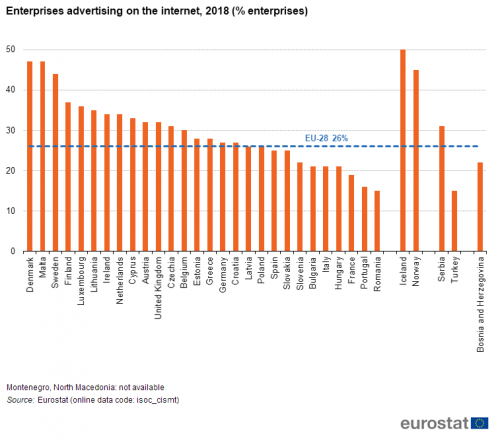
Source: Eurostat (isoc_cismt)
The use of contextual advertising was far more popular than the other types of targeted internet advertising. This is most likely because the technologies embedded into webpages are easy to implement. Some 80 % of EU businesses advertising on the internet used information from the content of internet surfers’ webpages or keywords from their queries to identify the audience accurately before sending relevant ads. In ten EU countries this type of advertising was used by more than 80 % of businesses using internet ads.
Behavioural targeting and geo-targeting were used by 32 % and 37 % of EU businesses respectively. Some 38 % of businesses reported using targeted internet advertising methods other than those mentioned above. For behavioural targeting, the highest shares were recorded in Estonia (54 %), Finland (49 %), Cyprus (48 %), the Netherlands (43 %) and Malta and Portugal (both 42 %). Geo-targeting was used by more than half of businesses advertising online in Cyprus (55 %) and Ireland (51 %), followed by the United Kingdom (47 %), Malta (46 %), the Netherlands and Portugal (both 45 %) (Table 1).
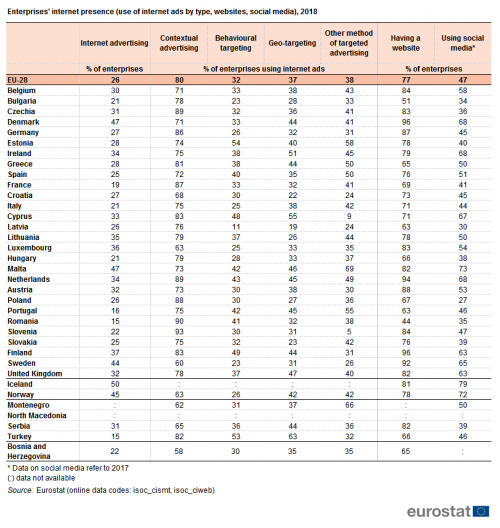
Source: Eurostat (isoc_cismt) and (isoc_ciweb)
As Figure 2 shows, for the businesses that used internet ads, the distribution of the types of online advertising methods used did not differ much between enterprises of different size groups. Contextual advertising was used by 80 % of SMEs and 82 % of large companies, behavioural targeting by 31 % of SMEs but 46 % of large companies, and geo-targeting ads by 36 % of SMEs but 44 % of large companies.

Source: Eurostat (isoc_cismt)
As Figure 3 shows, companies providing accommodation services most fully embraced contextual advertising (43 %). In this specific economic sector, behavioural targeting and geo-targeting were used by 20 % and 23 % of EU businesses respectively.
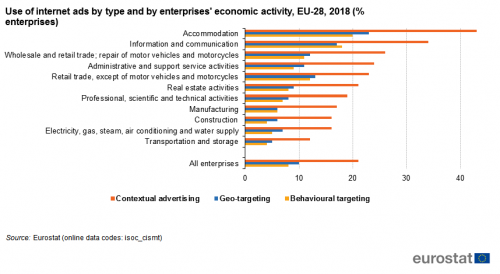
Source: Eurostat (isoc_cismt)
The use of highly dynamic features provided by websites’ advanced functionalities and social media has allowed companies not only to embrace this new generation of internet communication platforms but also to extend the reach of their advertising. Some 77 % of EU businesses reported having a website in 2018, out of which 25 % reported using internet advertising as well. Almost all businesses that reported using internet advertising had a website. As shown in Figure 4, the points cluster in a band from the lower left to the upper right, thus showing a positive relationship between businesses with a website (vertical axis) and those that use internet advertising (horizontal axis).
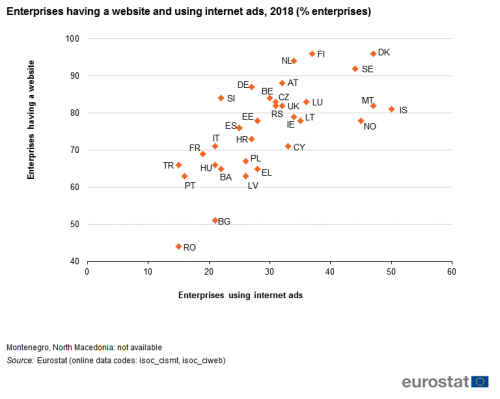
Source: Eurostat (isoc_cismt) and (isoc_ciweb), see list of country codes
Social media are mainly used by businesses to build their image and market their products (see article Social media - statistics on the use by enterprises). In 2017, 47 % of EU businesses used social media, such as social networks, blogs, content-sharing sites or wikis (Table 1).
Internet advertising is not only used by companies that sell to consumers online. In fact, it is mostly used by companies selling offline. Overall, out of 26 % of EU businesses advertising on the internet, only 7 % also made web sales to private consumers. However, in the accommodation sector, almost 40% of companies that advertised over the internet also made web sales to private consumers (Figure 5).
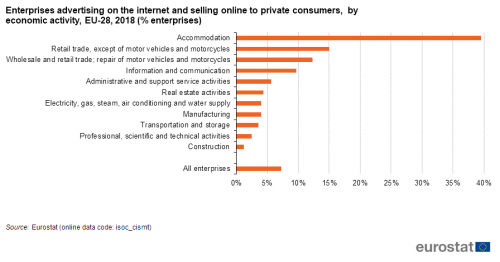
Source: Eurostat (isoc_cismt)
Data sources
The data presented in this article are based on the results of the 2017 and 2018 European Union survey on ‘ICT usage and e-commerce in enterprises’.
Statistics were obtained from business surveys conducted by national statistical authorities in these years. The statistical observation unit is the 'enterprise', as set out in Regulation (EC) No 696/1993. The survey covered enterprises (i.e. businesses) employing at least 10 people.
Economic activities correspond to the NACE Revision 2 classification. The sectors covered are manufacturing; electricity, gas and steam; water supply; construction; wholesale and retail trades; repair of motor vehicles and motorcycles; transportation and storage; accommodation and food service activities; information and communication; real estate; professional, scientific and technical activities; administrative and support activities; and repair of computers and communication equipment. Businesses are broken down by size into small (employing 10-49 people), medium (50-249 people) and large companies (250 or more people).
In 2018, 158 000 out of 1.6 million businesses in the EU-28 were surveyed. Of the 1.6 million, approximately 83 % were small businesses, 14 % were medium and 3 % were large.
Data in tables shown as ‘:’ refer to data that are unavailable, unreliable, confidential or not applicable. Unreliable data are included in the calculation of European aggregates.
Data presented in this article refer exclusively to paid internet advertising (paid ads) and may differ from data in the database, due to updates made after data were extracted for use in this publication.
Context
The Digital Single Market for Europe is a major priority of the European Commission. The strategy is built on three pillars: (1) better access for consumers and businesses to digital goods and services across Europe; (2) creating the right conditions and a level playing field for digital networks and innovative services to flourish; (3) maximising the growth potential of the digital economy. Online platforms — parts of which are social media — play an increasingly central role in social and economic life and are an important part of a thriving internet-enabled economy.
The wider EU policy interest is to spot business opportunities for launching services based on the internet and key enabling technologies such as social media, cloud computing, use of 3D printing, etc. Websites offering dynamic features to visitors and participation in social media are an important part of the digital technologies that businesses use to increase their internet presence, improve marketing and advertising opportunities, and communicate and interact with partners, customers and other organisations. In this context, internet advertising enables businesses to market their products and services more effectively and to improve their targeting of relevant audiences.
Direct access to
Other articles
- E-business integration
- E-commerce statistics
- ICT security in enterprises
- Social media - statistics on the use by enterprises
- Cloud computing - statistics on the use by enterprises
- ICT specialists - statistics on hard-to-fill vacancies in enterprises
- Digital economy and society statistics - enterprises
Main tables
Database
- ICT usage in enterprises (isoc_e)
- Websites and use of social media (isoc_cism)
- Websites and functionalities (isoc_ciweb)
- Social media use by type, internet advertising (isoc_cismt)
- Social media use by purpose (isoc_cismp)
- Websites and use of social media (isoc_cism)
Dedicated section
Methodology
- ICT usage and e-commerce in enterprises (ESMS metadata file - isoc_e_esms)
Legislation
- Regulation (EC) No 808/2004 of 21 April 2004 concerning Community statistics on the information society
- Summaries of EU legislation: Statistics on the information society
- Regulation (EC) No 960/2008 of 30 September 2008 implementing Regulation (EC) No 808/2004 concerning Community statistics on the information society
- Regulation (EC) No 1023/2009 of 29 October 2009 implementing Regulation (EC) No 808/2004 concerning Community statistics on the information society
- Regulation (EU) No 821/2010 of 17 September 2010 implementing Regulation (EC) No 808/2004 concerning Community statistics on the information society
- Regulation (EU) No 937/2011 of 21 September 2011 implementing Regulation (EC) No 808/2004 concerning Community statistics on the information society
- Regulation (EU) No 1083/2012 of 19 November 2012 implementing Regulation (EC) No 808/2004 concerning Community statistics on the information society
- Regulation (EU) No 859/2013 of 5 September 2013 implementing Regulation (EC) No 808/2004 concerning Community statistics on the information society
- Regulation (EU) No 1196/2014 of 30 October 2014 implementing Regulation (EC) No 808/2004 concerning Community statistics on the information society
- Regulation (EU) 2015/2003 of 10 November 2015 implementing Regulation (EC) No 808/2004 concerning Community statistics on the information society
- Regulation (EU) 2016/2015 of 17 November 2016 implementing Regulation (EC) No 808/2004 concerning Community statistics on the information society
- Regulation (EU) 2017/1515 of 31 August 2017 implementing Regulation (EC) No 808/2004 concerning Community statistics on the information society
- Regulation (EC) No 696/1993 of 15 March 1993 on the statistical units for the observation and analysis of the production system in the Community
- Summaries of EU legislation: EU production system — statistical units